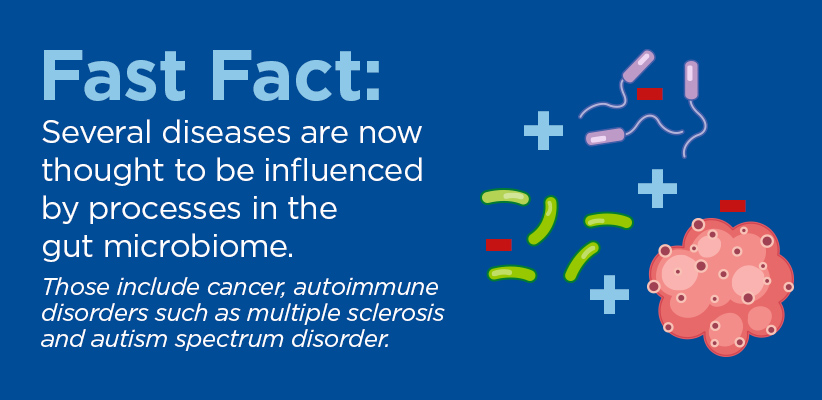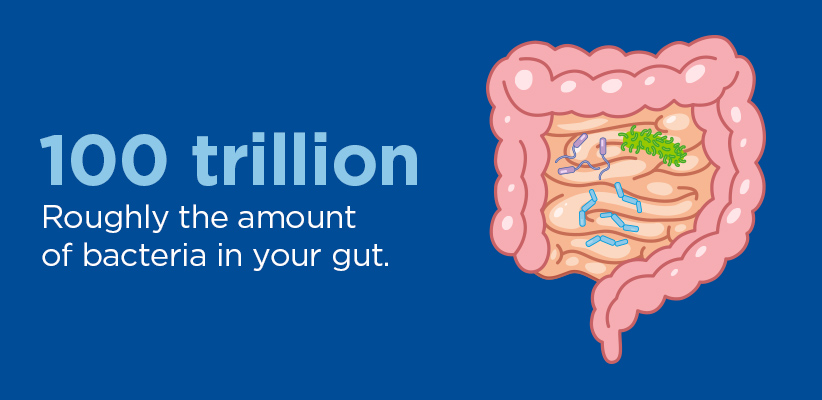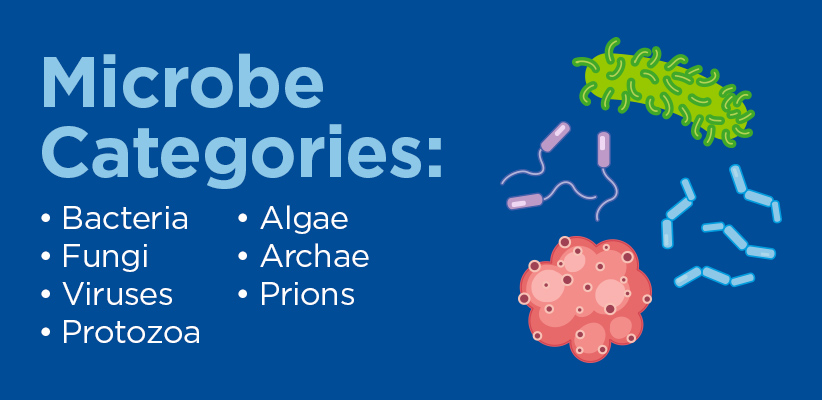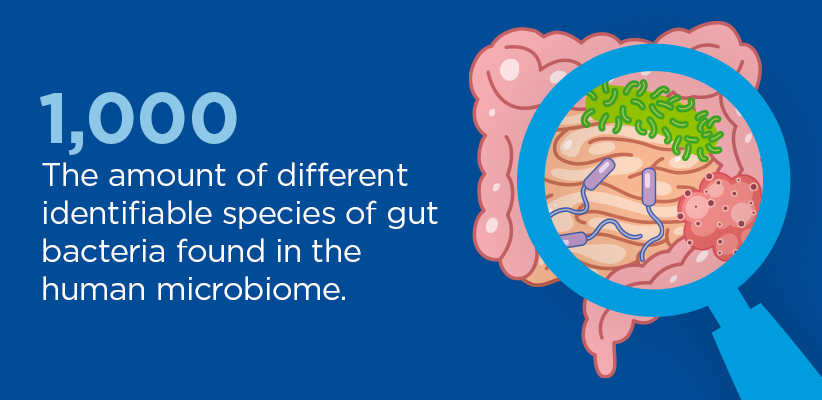Humans are teeming with tiny organisms that affect our health — in good ways and bad. Each person is a vessel, a self-contained ecosystem for vast quantities of these creatures, known as microbes, which are in a constant state of turmoil, sloshing and churning in a symphony of imperceptible motion that’s responsible for sending chemical signals throughout the bloodstream.
Every crevice is a home for microbes with a specific job to perform. In the gastrointestinal system alone (more colloquially referred to as “the gut”), there are roughly 100 trillion bacteria. The bacterial battles being waged in the stomach and intestines directly impact other aspects of a person’s overall health, even brain function.
No animal can exist without microbes; they are an essential characteristic of a living being. It’s a symbiotic relationship that evolves over a lifetime, a host and a pack of hungry party guests that just won’t leave.
Laboratory scientists are still reckoning with how this relationship functions, but a golden age of discovery is underway. Medical lab science can help unravel the microbial mysteries that regulate our moods, dictate our diets and defend us from contaminants that contribute to long-term health issues.
Curious and creative lab scientists are needed to explore the links between digestive health and neurological health. Microbe research may hold the key to treating conditions like anxiety, depression and autism spectrum disorder, as well as autoimmune diseases such as multiple sclerosis and ulcerative colitis.

What are microbes and where are they found?
So what are microbes? They’re commonly defined as single-celled organisms too small to be seen without the use of a microscope. But in some cases, a cluster of cells can be classified as a microbe. Some microbes are eukaryotes, which are characterized by a well-defined, membrane-bound nucleus, while others (prokaryotes) lack this feature.
Historically speaking, microbiology has roots that can be traced back to the late 1800s, when French chemist Louis Pasteur — perhaps best known for the eponymous food preparation process of pasteurization — discovered that bacteria are responsible for fermentation. Pasteur, Germany’s Robert Koch and a handful of their contemporaries were among the first in the field to determine microbes’ functions in the body. They devised techniques for cultivating and observing specimens in the laboratory setting.
There are seven main types of microbes: bacteria, fungi, viruses, protozoa, algae, archaea and prions. They all have distinct roles to play and unique characteristics. Bacteria constitute the majority of the microorganisms living in the body. Scientists once believed they outnumbered human cells by a factor of 10-to-1. That figure has been debunked; researchers in Israel and Canada now estimate the ratio is closer to 1-to-1.
For years, researchers neglected to posit the interconnectedness of the systems within the body. Instead, experts in the field focused on identifying and eliminating bacteria that cause infectious diseases (called pathogens). But over the past decade, an emerging discipline of microbiology has begun to examine the inverse — the “good” bacteria, so to speak — and why they’re so crucial to maintaining a healthy body from head to toe.

Microbes can be found just about everywhere inside and outside the body. There are thousands of microbe species, and some of the most interesting subpopulations — called microbiomes — reside in the nose, the armpit, male and female genitalia, the belly button (home to the umbilical microbiome) and even the eyes.
Some microbes are passed from mother to baby during and immediately following childbirth. Many essential microbes are acquired in early childhood when we are first exposed to dirt, grime and disease — the building blocks of our immune systems. Throughout our lives, millions more gain entry from the places we inhabit and the surfaces we touch. They travel through plumbing, hitch a ride on our pets and are passed from doorknobs, ATM keypads and a host of other high-traffic areas for germs.
In totality, the trillions of microbes in the body comprise the human microbiota. Populating it with a diversity of “good” bacteria balances out any pathogens present, creating an equilibrium in the digestive tract that’s integral to staving off the development of certain chronic conditions like obesity, diabetes and asthma. Most of the bacteria in the body is concentrated in the gut and specifically the intestines, so it’s no surprise that many medical laboratory scientists have shifted their focus to study the gut microbiome and how food and drugs interact with it.

Probiotics and the future of microbe research
There is still so much microbiology terrain that is unexplored, but British epidemiologist David Strachan made a discovery in 1989 that continues to steer researchers in exciting new directions. Strachan’s hygiene hypothesis (also known as the biome depletion theory) states, “The problem with extremely clean environments is that they fail to provide the necessary exposure to germs required to ‘educate’ the immune system so it can learn to launch its defense responses to infectious organisms.”
In effect, humans are too clean. The advent of antibiotics, antibacterial soaps and pocket-sized sanitizing implements ushered in a collective weakening of the human immune system and the systematic termination of essential microbes. Antibiotics are indiscriminate, targeting pathogens but also wiping out swaths of beneficial bacteria — including the vital supply of the roughly 1,000 identifiable species in the gut. Infectious diseases are less prevalent but there’s been an influx of chronic illnesses. Asthma in children, for instance, has seen a spike amid this movement.
The body eventually replenishes its supply of microbes naturally, but often at a rate too slow to ward off those hostile pathogens. In the absence of a robust contingent of our tiny companions, our defenses are lowered — an ironic development given humans’ resolve in the fight against germs.
Research is being conducted to determine whether the gut microbiome can be aided by foods and supplements purportedly rich in probiotics, which are defined by the National Center for Complementary and Integrative Health as “live microorganisms intended to have health benefits when consumed or applied to the body.” In addition to capsules, sprays and topical solutions, probiotics are present in fermented foods like yogurt, buttermilk, sourdough bread and pickles.
However, the long-term benefits of such products on certain chronic medical conditions haven’t been borne out. In some cases, probiotics can cause infections in immune-compromised individuals by introducing bacteria that are not native to the body. Some microbiologists are actively seeking to tamp down the hype, noting how people with healthy GI tracts see very little benefit from probiotics.
Despite the inherent limitations, probiotics are central to the kind of revolutionary microbe research that could lead to breakthroughs in the development of new drugs and therapeutic treatments. What are microbes’ roles in this research? One avenue involves testing on animals, in which manipulation of the gut microbiome has yielded behavioral changes that confirm the link between digestive health and brain function. Changes to microbe composition send chemical signals that make neurons fire differently, suggesting that specific probiotics could be used in concert with a certain diet to decrease the risk of seizures in people who have epilepsy.
The comorbidity of depression and anxiety with gastrointestinal issues such as irritable bowel syndrome and Crohn’s disease has some scientists investigating whether microbes could be used to help those affected mitigate their symptoms and manufacture more mood-stabilizing serotonin. Neurodegenerative diseases like Parkinson’s and Alzheimer’s and certain forms of cancer could also benefit from microbe research. Other medical lab scientists take a broader view, looking at how the different types of microbes communicate with cells in the body and how many different kinds of messages can be sent this way.

The past decade has produced extraordinary discoveries related to the human microbiota, and the decade ahead is expected to yield more of the same. For instance, germ-free mice could enable medical lab scientists to transfer whole microbiome configurations and apply their findings to the causality of human diseases. There’s also evidence to suggest that studying metabolites –the biochemical products produced by the microbes – could be used to classify certain microbes, which would allow lab scientists to better understand their function within a microbiome.
Microbes will also play a role in the future of larger environmental matters, including climate change. The effects of pollution and global warming on the earth’s smallest species can help predict how larger animals will cope with atmospheric phenomena. Accordingly, medical lab scientists must exhibit a tenacity for problem-solving and analytical thinking. They are the explorers of the medical world, and breakthroughs are dependent upon their boldness and creativity.
A dynamic career path in medical laboratory science
The University of West Florida’s online medical laboratory technician to medical laboratory scientist (MLT to MLS) bachelor’s program offers students a chance to level up and prepare for an in-demand career on the front lines of this dynamic field. For over 40 years, the department’s expert faculty have trained medical technicians to become certified MLS professionals through advanced training and a rigorous curriculum that includes courses covering the fundamentals of clinical diagnosis, bacteria associated with infectious diseases and the principles and procedures of blood bank and transfusion services.
The fully online program — recognized by the National Accrediting Agency for Clinical Laboratory Sciences and licensed by the state of Florida’s Board of Clinical Laboratory Personnel — can be completed in as little as two years, affording students the flexibility to learn around a busy schedule. They’ll acquire all the necessary expertise to take the American Society for Clinical Pathology (ASCP) national board exam, which is required for MLS qualification.
Learn more about the University of West Florida’s NAACLS-accredited online MLT to MLS bachelor’s program.

